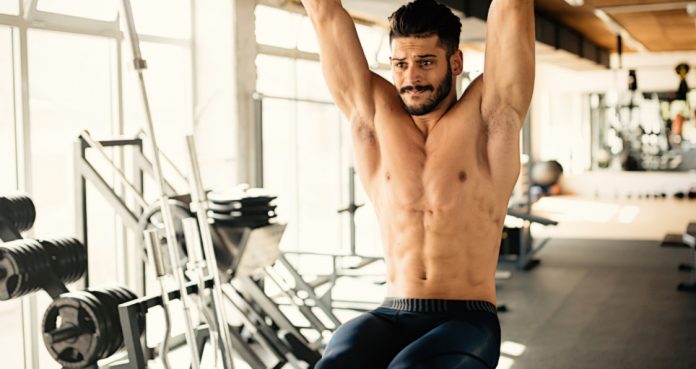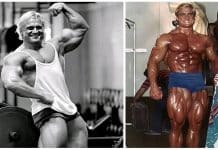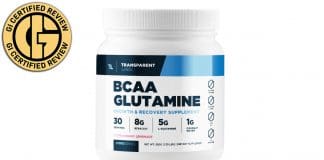
Hanging Leg Raise Routine
The hanging leg raise is an isolation exercise which develops the abdominal muscles and hip flexors – specifically, the rectus abdominis, obliques, iliopsoas and rectus femoris (1). Isolation exercises are movements that involve motion around only one joint; with the hanging leg raise, the driving movement should occur around the hip joint to maximize the amount of stress placed on the aforementioned muscles and cause adaptation.
By regularly performing the hanging leg raise, it is possible to improve the strength of the core musculature. For many, “the core” simply refers to the abdominals. In actuality, the core consists of all muscles found in the trunk of the body. In simpler terms, all the muscles of the body, excluding muscles of arms and legs, form the core (2).
The core’s function is to provide stability to the entire body through the use of muscular contractions. It is well documented that improving one’s core strength can bring about a whole host of positive changes and improvements such as, prevention of injury, improved posture, enhanced balance and facilitate efficient movement (3).
In order to effectively improve the strength of the core, it is imperative to partake in regular strength training. Exercises that target specific muscle groups of the core can certainly be of benefit. However, recognizing that the core’s function is to stabilize, exercises which place the body in an unstable environment will force the core to react and consequently adapt more effectively.
While the hanging leg raise is primarily an effective core developing exercise, an aspect which is often overlooked is the fact that a large degree of upper body strength is also required in order to hold the body in the correct position. The deltoids, trapezius and rhomboids, along with a multitude of smaller stabilizing muscles, must all contract to hold the body upright. Therefore, the hanging leg raise can also be considered effective for building upper body strength.
Safety Precautions
The first precaution that should be made, is to ensure that the equipment being used is well maintained and in good working order. This is especially true for those who have their own home equipment.
It is always wise to consult a medical professional before beginning any physical exercise. This is of even greater importance for those who are recovering from injury or surgery, those with a pre existing medical condition and those who are pregnant or have experienced diastasis recti.
Hanging Leg Raise Coaching Points
For the hanging leg raise, a gym workstation or captains chair should be used in order to fix the body in position. Both pieces of equipment allow the user to place their arms on the frame and support their own bodyweight while in a suspended position. Although these types of equipment come in a variety of shapes and sizes, the vast majority of gyms will have some type of workstation or chair which will allow for hanging leg raises.
In order to effectively perform the hanging leg raise, run through the following coaching points.
1) Position yourself within the frame and rest your forearms on the arms of the chair. If the chair has handles, grab on to both and hold tight.
2) Squeeze the muscles of the core, take a big breath and step off, holding your body in midair.
3) From this suspended position, focus on bringing the knees upwards. Avoid driving the knees any higher than waist height.
4) As you lower the legs back to the starting point, continue to brace the core muscles while exhaling.
5) If possible, perform 8 – 10 reps and repeat for 3 sets. Ensure you take 1-2 minutes rest between each set.
Common Execution Mistakes
There are a number of errors that should be avoided when performing this exercise. By failing to perform exercises with correct technique, not only are we failing to work the muscles effectively, but we are also increasing the chances of experiencing or developing injury.
Arching The Back
When setting up for the exercise, it is imperative that the back is pressed firmly into the support (providing the equipment has appropriate supports). This will prevent arching, specifically of the lower spine, which can cause problems and increase one’s risk of injury. Finally, ensure to keep the neck and head steady throughout the exercise as head and neck movement may exaggerate spinal flexion.
Failing to Engage the Core
No matter which exercise is being performed, whether it be a heavy squat or a simple bicep curl, engaging the core is essential. With each rep of the hanging leg raise, look to squeeze the muscles of the core and keep as tight as possible. This will help to place maximal demand on the abs and hip flexors while keeping each movement controlled and safe, thus reducing injury risk.
Using Momentum
This error ties in nicely with the above point; by bracing the core, it is possible to eliminate the use of momentum. Uncontrolled swinging of the legs may indeed make the exercise easier, however, momentum is at play and reducing the demand placed on the muscles. Look to keep every movement controlled – especially on the way down where it can be tempting to simply drop the legs instead of lowering them in a controlled fashion.
Breath Holding
Failing to breathe with each repetition is not recommended. Breath holding combined with the stress and strains associated with the exercise can rapidly increase one’s blood pressure. This increase in pressure is known as the Valsalva maneuver and, while it has been found to increase intra-abdominal pressure and may therefore assist in maintaining stability, can cause dizziness, heart rate alterations and, in extreme cases, fainting (4).
It can be easy to forget to breathe when squeezing the core. Aligning breathing with each leg lift can be a useful tactic. Breathe in on the way up, breathe out on the way down and repeat.
Hanging Leg Raise Regressions and Progressions
Don’t worry if completing 8-10 reps of this exercise is a struggle. If this is the case, look to perform as many reps as possible and as the weeks progress and quickly the 8-10 rep range will become much more achievable.
If, however, it is a struggle to get into the correct position on the frame or if the movement itself is too challenging, there is an alternative exercise that can be performed instead. The lying leg raise replicates the movements involved in the hanging variation, however, it removes the suspension element and instead lies the individual flat on their back which greatly simplifies the exercise.
There are a number of variations that we can use in order to increase the difficulty and challenge of the hanging leg raise. It would be wise to move onto these progressions when it is possible to comfortably complete 8-10 reps of conventional hanging leg raises.
Straight Leg Raises
The first progression involves a simple change in form to increase the intensity of the movement. Instead of focusing on hinging the knees and bringing them upward, simply look to maintain straight legs throughout as the legs lift and lower.
Pull-Up Leg Raise
A second method for progressing the hanging leg raise, is to use a pull up bar instead of a chair or workstation. By doing this, there are no supports to hold the body in place and therefore, it truly becomes a “hanging” exercise.
The challenge with the pull-up bar variation is that the body is likely to start swinging as movement is generated around the hips and knees. Therefore, a greater demand is placed on the core and stabilizing musculature of the body to prevent excessive swinging and hold the body in position.
Captain’s Chair Kicks
For this exercise variation, lock the body into the captain’s chair and brace the core. From that position, raise only one leg up to waist height and perform a flutter kick. Then, alternate leg and replicate the same movement once again. For an added challenge, lift both legs up and flutter kick simultaneously. This will maintain tension on the abs and hip flexors for a prolonged duration thus causing great strength adaptations.
Captain’s Chair Twists
The final variation will focus more on the obliques which are the muscles found on the side of the body and assist in twisting and rotation. For the chair twists, as the legs begin to rise up, add some rotation by bringing the legs out to the side of the body. After a number of reps, the obliques will definitely be burning!
Final Word
There is no doubt that, when performed correctly, the hanging leg raise is one of the most effective exercises for developing the core and has been found to specifically place a large demand on the abdominals (5). Therefore, if the goal is either to improve core strength or to develop the abs, this exercise should absolutely be incorporated into training sessions.
For more news and updates, follow Generation Iron on Facebook, Twitter, and Instagram.
References:
1- Kim, Kanghoon; Lee, Taesik (2016-2). “Comparison of muscular activities in the abdomen and lower limbs while performing sit-up and leg-raise”. Journal of Physical Therapy Science. 28 (2): 491–494. doi:10.1589/jpts.28.491. ISSN 0915-5287. PMC 4792997. PMID 27065536.
2- Huxel Bliven, Kellie C.; Anderson, Barton E. (2013-11). “Core Stability Training for Injury Prevention”. Sports Health. 5 (6): 514–522. doi:10.1177/1941738113481200. ISSN 1941-7381. PMC 3806175. PMID 24427426.
3- Publishing, Harvard Health. “Core conditioning — It’s not just about abs”. Harvard Health
4- Hackett, Daniel A.; Chow, Chin-Moi (2013-8). “The Valsalva maneuver: its effect on intra-abdominal pressure and safety issues during resistance exercise”. Journal of Strength and Conditioning Research. 27 (8): 2338–2345. doi:10.1519/JSC.0b013e31827de07d. ISSN 1533-4287. PMID 23222073
5- McGill, Stuart; Andersen, Jordan; Cannon, Jordan (2015). “Muscle activity and spine load during anterior chain whole body linkage exercises: the body saw, hanging leg raise and walkout from a push-up”. Journal of Sports Sciences. 33 (4): 419–426. doi:10.1080/02640414.2014.946437. ISSN 1466-447X. PMID 25111163.















